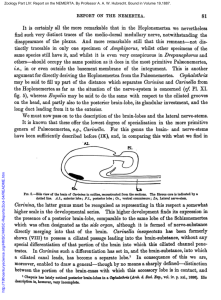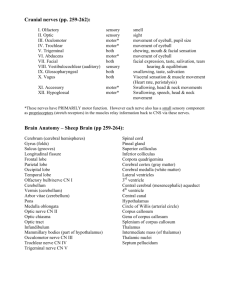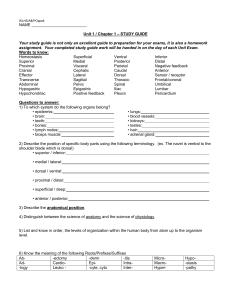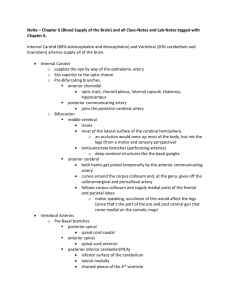Brain Dissection and Atlas - Stony Brook University School of Medicine
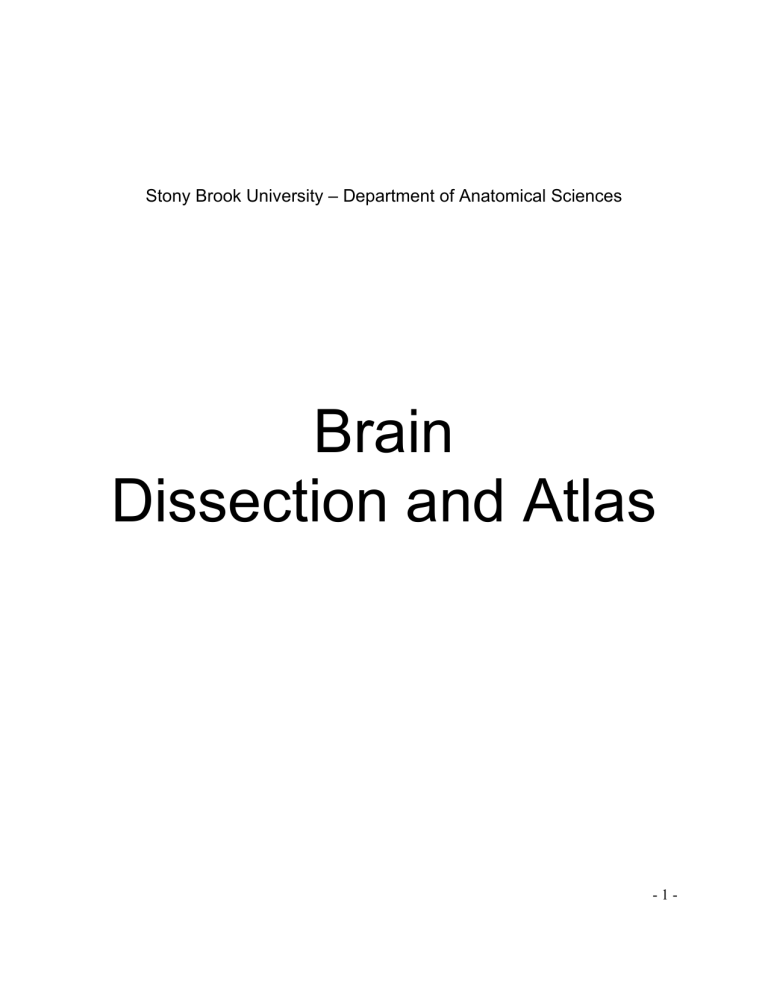
Stony Brook University – Department of Anatomical Sciences
Brain
Dissection and Atlas
- 1 -
LABORATORY SELF STUDY AND DISSECTION INSTRUCTIONS FOR THE BRAIN
DAY 1
Review on the skull and in the cadaver: a) the position of foramina and fissures through which cranial nerves leave the neurocranium; b) the position of the hypophysis (pituitary gland) and infundibulum; the position of the optic nerves, chiasm, and optic tracts; the position of the internal carotid arteries and their relation to the cavernous sinus. c) the tentorium, falx cerebri and falx cerebelli, and observe their relation to the neurocranium, cerebrum, and cerebellum; d) the arachnoid granulations; observe their position relative to the superior sagittal sinus.
Examine the arachnoid on the gross brain:
a) compare and contrast the conformation of the dura, arachnoid, and pia to the surface of the brain; b) locate the cerebellomedulllary cistern, a large subarachnoid space (often collapsed); understand where it lies in the cranial cavity; c) before removing the arachnoid, identify the major elements of the vascular system of the brain.
Blood supply of the brain (use figures in your regular atlas for this section)
Study the blood supply in the cranial cavity and on the cadaver brain. If the blood supply on your specimen is incomplete, be sure to look at brains from other cadavers. a) Basilar artery
Trace the route of the vertebral arteries through the foramen magnum and along the ventral surface of the medulla where they join to form the basilar artery.
The basilar a. divides into two terminal arteries, the posterior cerebral arteries, at the superior edge of the pons.
Locate on the inferior aspect of the brain: vertebral aa. basilar a. posterior inferior cerebellar aa. (branches of the vertebral aa.) anterior inferior cerebellar aa. (branches of the basilar a.) superior cerebellar aa. (branches of the basilar a.) posterior cerebral arteries (branches of the basilar a.)
- 2 -
Trace: the course of the anterior and posterior inferior cerebellar arteries onto the convex surface of the cerebellum; the course of the superior cerebellar arteries onto the superior surface of the cerebellum; the course of the posterior cerebral artery over the tentorium and onto the medial and inferior surfaces of the occipital lobe and the inferior surface of the temporal lobe. b) Internal carotid artery
In the basicranium (cadaver) trace the route of the internal carotid aa. through the carotid canal and cavernous sinus and the anterior clinoid processes of the sella turcica. The internal carotid a. gives of the ophthalmic a. and then branches into large middle cerebral and smaller anterior cerebral arteries.
Locate on the brain: internal carotid aa. anterior cerebral aa. (branches of the internal carotid a.) anterior communicating a. middle cerebral aa. (branches of the internal carotid a.) posterior communicating aa.
Trace: the course of the middle cerebral artery laterally into the lateral fissure and onto the convex surface of the cerebrum. This artery supplies the insula and the convex surface of the frontal, parietal and temporal lobes. the course of the anterior cerebral artery into the longitudinal fissure. The two anterior cerebral arteries are interconnected by the anterior communicating artery just anterior to the optic chiasm.
The anterior cerebral artery supplies the orbital and medial surfaces of the frontal lobes and the medial surface of the parietal lobe. the course of the posterior communicating artery to the point of convergence with the posterior cerebral artery.
The anterior and middle cerebral arteries give rise to many penetrating arteries to the thalamus and basal ganglia. Tearing these arteries away from the area just posterior to the olfactory trigone reveals many small holes from which penetrating arteries were removed -- this is the anterior perforated substance (fig. 3). The posterior perforated substance (fig. 3) is in the interpeduncular fossa, an area which lays over the substantia nigra and the red nucleus. c) The Circle of Willis
Trace the arterial segments that make up the anastomotic Circle of Willis. The posterior communicating arteries usually have a narrow lumen, and one of the communicating arteries may be absent in some individuals.
Dissection of the circle of Willis:
Cut the major branches of the circle of Willis at ~ 1" away from the circle or their origin on the basilar or vertebral aa.. Carefully remove the circle of Willis with its branches and pin them on a piece of cardboard. Label the branches. Use atlas or dissector figures for guidance.
- 3 -
Venous drainage
The venous drainage does not (as a rule) follow the arterial blood supply. It is composed of veins located on the surface of the brain which enter the venous dural sinuses. The sinuses have been studied in a previous lab. Identify on the brain the great cerebral vein of Galen that runs between the occipital lobe of the cerebrum and the cerebellum and feeds into the straight sinus.
Gross structure of the brain
Remove the arachnoid from your specimen. Remove the blood vessels from the specimen.
The pia is adherent to the brain surface. Use the figures in this book to aid in the identification of structures on your specimen. A photographic atlas (color) is posted under supplementary materials on the webpage. Hard copies are available in the anatomy department conference room HSC 8, room 80. They can be studied in the conference room but cannot be checked out.
Dissection: Midsagittal section
Place the cadaver brain such that the convex surface faces upward. Using a brain knife (not scalpel!) separate the longitudinal fissure (fig. 1) exposing the corpus callosum. Make an incision beginning at the posterior edge (splenium) extending anteriorly to the anterior margin
(genu). Be careful not to cut through the pia located under the corpus callosum. If you gently separate the cut edges of the corpus callosum, you will be looking down on the membranes making up the roof of the 3rd ventricle. Make an incision through these membranes. If you are careful to visualize before you cut, you will be able to cut between the converging fornices
(singular: fornix), through the interthalamic adhesion, through the anterior commissure, and to separate the two layers of the septum pellucidum. You are now looking down into the 3rd ventricle. Masses of choroid plexus are visible along the under surface of the roof membrane.
Carefully turn the brain so that the inferior surface faces upward. Separate the longitudinal fissure anterior to the optic chiasm. Begin an incision at the anterior edge of the optic chiasm continuing posteriorly through the infundibulum and between the mammillary bodies. Complete the midsagittal incision through the brainstem and cerebellum.
You now have two hemispheres and your lab group can split up into two groups of three students for the following identifications.
Identify the three principal divisions of the brain and their most important subdivisions on the medial surface (figs. 4 and 6).
I. Forebrain ( = prosencephalon)
Telencephalon: cerebral hemispheres, basal ganglia*
Diencephalon: thalamus, epithalamus (pineal gland), hypothalamus
II. Midbrain ( = mesencephalon)
Cerebral peduncles*, quadrigeminal lamina (superior and inferior colliculi), tegmentum
III. Hindbrain ( = rhombencephalon)
Metencephalon (pons, cerebellum, tegmentum)
Myelencephalon (medulla oblongata)
(*not visible in midsagittal section)
- 4 -
Lateral surface of the telencephalon (fig. 2)
Observe the sulci, fissures and gyri of the cerebral hemispheres. If the cerebral hemisphere is compared to a fist, the frontal lobe corresponds to the partially flexed fingers, the temporal lobe to the thumb and the occipital lobe to the wrist. The intermediate dorsum of the hand corresponds to the parietal lobe.
Locate: lateral fissure (corresponds to groove between thumb and forefinger) - It separates the temporal lobe from the frontal and parietal lobes. central sulcus - It extends from the longitudinal fissure, overlapping only slightly on the medial surface, to the lateral fissure. The sulcus may be discontinuous on some specimens. This sulcus is the posterior border of the frontal lobe and the anterior border of the parietal lobe. The gyrus anterior to the central sulcus is the precentral gyrus; that posterior to it is the postcentral gyrus. pre-occipital notch - This notch is located at the inferior, lateral edge of the telencephalon at about the point at which the cerebellum contacts the inferior surface. An imaginary line extended from the parieto-occipital sulcus (medial surface, see below) and occipital notch superiorly to the pre-occipital notch inferiorly forms the border between the occipital lobe posteriorly and the parietal and temporal lobes anteriorly.
Delimit frontal, parietal, temporal, occipital lobes.
Carefully separate the lateral fissure. The under surfaces of the lobes in the lateral fissure are known as opercula (e.g., operculum of the frontal lobe) The cerebral cortex which overlies the basal ganglia bulges in the lateral fissure forming a small lobe known as the insula (fig. 10).
Identify the transverse gyri of Heschl (fig. 10) on the superior surface of the temporal lobe facing the lateral fissure (auditory area in left hemisphere).
Inferior or ventral surface of the brain
Refer to skull:
The inferior surface of the frontal lobe lies in the anterior cranial fossa on the superior surface of the orbit - orbital surface of frontal lobe. The inferior surface of the temporal lobe lies in the middle cranial fossa. The postero-inferior surface of the cerebellum lies in the posterior cranial fossa.
Identify the following structures on the brain using figs. 3 and 5: olfactory bulbs and tracts infundibulum (pituitary or hypophysis in cadaver) mamillary bodies cerebral peduncles interpeduncular fossa (posterior perforated substance) pons basis medulla oblongata
- 5 -
pyramids olive cranial nerves II to XII (the smaller ones may be broken off
Midsagittal or medial surface of the brain
Locate the following structures on the medial surface of the cerebral hemisphere using fig. 4: frontal lobe, parietal lobe, occipital lobe parieto-occipital sulcus calcarine sulcus cingulate gyrus corpus callosum: splenium, body and genu anterior commissure septum pellucidum fornix
3rd ventricle interventricular foramen thalamus and interthalamic adhesion hypothalamus infundibulum optic chiasm pineal body (gland) superior and inferior colliculi
Delimit the following subdivisions (figs. 4 and 6):
The diencephalon is the most superior segment of the brain stem. (Note that some textbooks do not include the diencephalon as part of the brainstem.) It is bounded laterally by the internal capsule, caudally by the midbrain and superiorly by the interventricular foramen. The diencephalon forms the lateral and anterior walls of the 3rd ventricle.
The midbrain (mesencephalon) is bounded superiorly by the diencephalon and inferiorly by the pons. The cerebral aqueduct passes through the midbrain dividing it into a tectum (posterior or dorsal) and a tegmentum (anterior or ventral) part. The latter part contains the red nucleus and the substantia nigra. The cerebral peduncles form the basal region of the midbrain. Note that
‘tectum’ (meaning ‘roof’) and ‘quadrigeminal lamina’ (meaning ‘four twins’) refer to the same region. The terms ‘superior and inferior colliculi’ differentiate the two pairs of projections of the tectum.
The hindbrain (rhombencephalon) is further divided into the metencephalon and myelenchalon
(fig. 6). The metencephalon consists of the cerebellum (posterior and dorsal), the tegmentum, and the pons (anterior and ventral). It contains a large part of the 4 th ventricle.
The myelencephalon, also called medulla oblongata, is bounded caudally by the spinal cord and anteriorly by the pons. The pyramidal decussation (fig. 5) on its basal aspect is at approximately the level of the foramen magnum. The superior half of the medulla is bounded posteriorly by the floor of the 4th ventricle. The caudal half of the medulla has a central canal which is continuous with the caudal end of the 4th ventricle and continues through the medulla and spinal cord to the conus medullaris of the spinal cord.
- 6 -
Dissection
Make an incision in the septum pellucidum and observe lateral ventricle caudate nucleus choroid plexus
Insert a probe through the interventricular foramen demonstrating the continuity between lateral ventricle and 3rd ventricle. Observe the continuation of the 3rd ventricle into the optic nerve, infundibulum and pineal body. Observe the line of attachment of the roof of the 3rd ventricle along the dorsomedial surface of the thalamus. Using fig. 4 as a guide, trace the outline of the
3rd ventricle from the interventricular foramen to the cerebral aqueduct.
Using the available models and x-rays, visualize the extent of the lateral ventricles within the lobes of the cerebrum. Locate the anterior, posterior and inferior horns within the cerebral hemispheres.
DAY 2
Dissection
Proceed with the dissections described in the following on only one hemisphere.
Keep the other one intact and use as a reference.
Carefully separate the cerebellum and the brainstem away from the inferior surface of the occipital lobe.
Make an incision through the mesencephalon, starting at the cerebral peduncles and proceeding up to the quadrigeminal lamina. You may now carefully detach the telencephalon, diencephalon and superior part of the mesencephalon from the inferior part of the mesencephalon and the rhombencephalon, including the cerebellum. Keep both parts for further study (see below).
Observe the red nucleus and substantia nigra, two ganglia in the tegmentum of the mesencephalon, at the cut surface. Note that the substantia nigra is indeed black (which is what ‘nigra’ means), but that the red nucleus is often pale in embalmed brains.
Telencephalon and diencephalon
On the basal (inferior) aspect of the brain force the temporal lobes to the side using your fingers.
Trace the optic tract into the lateral geniculate body. Observe the medial geniculate body next to it (a small bump next to the concave curvature of the more obvious lateral geniculate body; figs.
5 and 8).
Find the dentate gyrus on the basal aspect of the temporal lobe by gently pushing the fornix medially (fig. 12). Identify other parts of the limbic system; in the temporal lobe: parahippocampal gyrus with its uncus; in the mediansagittal plane: cingulate gyrus and continuation of fornix on its way to the mammillary body. Note that the hippocampal gyrus is visible only in sections (see frontal section below). It lies deep to the parahippocampal gyrus.
- 7 -
Dissection, tables with even numbers:
Use a brain knife (not your scalpel!) and make 2 horizontal sections through the telencephalon and diencephalon, starting at the mediansagittal surface.
1. At a level just below the body of the corpus callosum
2. At the level of the interthalamic adhesion
Study the cut surfaces and identify the following structures using fig. 7 and the intact hemisphere as a reference:
On section 1: gray and white matter of the telencephalon radiation of fibers from corpus callosum into the various parts of the cerebral cortex anterior and posterior horns of the lateral ventricle choroid plexus inside ventricle caudate nucleus in lateral wall of lateral ventricle
On section 2 (fig. 7): internal capsule caudate nucleus, head and tail lentiform nucleus and its two parts (putamen and globus pallidus or the pallidum) insular cortex thalamus anterior and posterior horns of lateral ventricle, stick a probe into the inferior horn
3rd ventricle
On the inferiormost part with the temporal lobes you should be able to trace the fornix into the temporal lobe and identify the dentate gyrus deep to it.
Study the frontal sections at one of the tables next to you.
Dissection, tables with odd numbers:
Use a brain knife (not your scalpel!) and make a frontal section through the telencephalon starting at the mediansagittal surface at the level of the mammillary bodies and interthalamic adhesion.
Identify on the cut surface using fig. 9 and the intact hemisphere as a reference: caudate nucleus (head and tail) lentiform nucleus (putamen and globus pallidus) internal capsule thalamus corpus callosum insular cortex lateral ventricle (note specifically the inferior horn in the temporal lobe) hippocampal and parahippocampal gyri
Study the horizontal sections at one of the tables next to you.
- 8 -
Brainstem and cerebellum
The cerebellum is attached to the pons by three large fiber bundles, the cerebellar peduncles. Carefully detach it from the brainstem by cutting through them (scalpel).
You have now opened the 4th ventricle (the cerebellum forms its roof).
Study the dorsal aspect of the (partial) brainstem and identify (fig. 8): cuneate fasciculus and tubercle gracile fasciculus and tubercle
In the brainstem tegmentum at the height of the 4th ventricle, motor nuclei are located medial and sensory nuclei lateral. In the brainstem caudal to the 4th ventricle and in the spinal cord, sensory nuclei and tracts lie posterior (dorsal) to the motor nuclei and tracts. Cuneate and gracile fasciculi are sensory fiber tracts coming from the upper and lower limbs, respectively, and the tubercles contain cell bodies on which they synapse on their way to the thalamus (another synapse) and postcentral gyrus.
Study the 4th ventricle:
Demonstrate the continuity with the 3rd ventricle by tracing the cerebral aqueduct.
Cerebrospinal fluid can only escape from the ventricular system into the subarachnoid space at three small apertures in the 4th ventricle. The median aperture - foramen of
Magendi - empties into the cerebellomedullary cistern. The two lateral apertures - foramina of Luschka - empty into the subarachnoid space lateral and posterior to pons. Look for choroid plexus protruding from that region. The 4 th ventricle is also continuous with the central canal of the spinal cord.
Cerebellum
It is customarily divided into an anterior lobe which lies under the occipital lobes and a posterior lobe which is convex and lies in the concavity of the posterior fossa of the neurocranium. It is also divided into a median vermis and lateral cerebellar hemispheres. The cortex is enfolded as is the cerebral cortex, but the folds are much narrower because the cerebellar cortex is much thinner than the cerebral cortex.
- 9 -
- 10 -
Atlas
- 11 -

